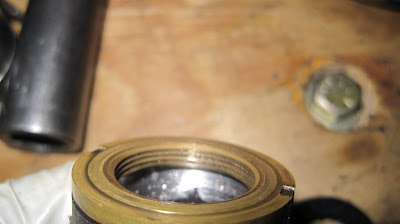Tonight I went over to Derek G.'s house and worked on the cush drive and clutch. We have some concerns about the clutch which need to be answered before I proceed.

Concern #1: Note the ridges in the bottom of the brass nut. This suggests that the needle bearings have rubbed against the brass ring

Concern #2: When I removed the needle bearings many fell out with a gentle tap, but there is a corner where the bearings would not come out and would not roll smoothly, even when I pushed them. I really pushed hard on these bearings and there was no movement. It took some effort.

When staring straight on at the bearing entrance, you can see that the spacing is not equal around the circumference. This may or may not be the design of Vespa. I don't know. If you do know, please speak up. When I felt the inside of bearing house I could feel an area at the bottom and marginally against the wall that did not feel as smooth as the rest and I wondered if this could be causing the bearings to bind maybe. But when I bench tested it a long time ago I could see the bearings moving through the oil hole.

Concern #3: Another concern I had is that it appears that the needle bearings are too tall and the brass ring nut is resting against the heads of the needle bearings and NOT the clutch surface. If this is indeed true, that could be a big problem.

We did not have any machinist dye to test this theory, but that is a next step.

What we did do is to measure the original needle bearing length against the new needle bearing length and they are exactly the same. I wonder though, if my original needle bearings are indeed original. They look in way too good of shape for 10,000 miles on dirt farm roads. I don't remember seeing an invoice when the engine and clutch were rebuilt for needle bearings, but I could be wrong.

Does anyone know the exact length the needle bearing should be?
Follow-up August 10, 2011:
As a back up I found a used stock clutch for $200, which seems too high. I spoke with Steve at ScooterWest and he agreed.
I wrote my mentor Tom G. to give him an update and he recommends a new clutch:
Here is what I wrote:
What I do know is this (after speaking to Steve at ScooterWest):
(1) my brass ring is scored, likely from the bearings touching it.
The NOS ones are perfectly smooth on both sides.
I don't know if this is a problem.
(2) the needle bearings get jammed in one corner of the clutch and
will not come out unless I use a screw driver and push them hard
around the circumference of the race until they loosen up. I am
unable to put new need bearings into the race at the same area and
need to put them in and use a screw driver to move them around the
circumference until they are all installed. The head of the race is
not 100% even around. Some of it is tighter and does not allow the
needle bearings to be removed or installed. Maybe this is by design,
maybe it is not.
I do not know if this is a problem.
The potential concern here is there could be binding of the needle
bearings and maybe that is causing my grinding sound between neutral
and 1st gear *only* because of the lower RPMs.
I hear your advice and it makes sense to just finish putting
everything together and back into the bike.
Jeremy
Tom's response:
That's news to me.
If the needles are binding up, then I'd go with a completely new clutch, since you don't know where the problem is.
I would not buy a used clutch if you can afford a new one.
Either of the SIP ones look good to me. Slight preference for original type . .
Tom
Further thoughts:
Thx again Tom.
I did not disassemble the clutch before removing the needle bearings
this time. Corks and plates and springs were all in place.
Also, I forgot I needed to use the clutch removal tool and followed a
manual two screw driver approach and gave some mild pressure to the
clutch on two sides to free it a couple times and then remembered I
needed my clutch removal tool. So I guess it is possible that I bent
it and caused the binding, but then again the problem existed before I
removed the clutch.
I was able to remove the needed bearings with no effort in the past
and reinstall them with no effort when the clutch was disassembled:
Could this cause a problem?
Or maybe this is not the problem and I just created a new one. I remember I had no problem reinstalling those needle bearings back in. I don't remember binding. I guess it doesn't matter now since there is binding.
Tom's response:
No way to tell if your prying caused the damage. I'd say unlikely, but conceivable. Also, there is NEVER any reason to remove the ring and needles without dismantling the clutch. That could EASILY have caused your binding problem. Take the clutch completely apart, then reassemble the needles and see if they bind.










